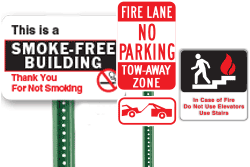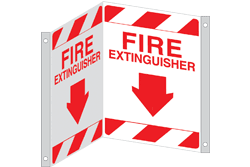Sign Requirements for Your Property

Federal, state, and local regulations regarding signs may impact your property. Be sure you have complete information on installation, size, and visibility of interior and exterior signs for your type of commercial property. Knowing the sign requirements for your industry and facility type will help you stay in compliance, pass inspections, and avoid expensive fines. Regulations vary by state, so always check local sign ordinances.

Parking Lots
Use traffic control and speed limit signs to increase safety and security in your parking lots, garage, and on your roads. Remember, you need at least one handicap parking space clearly marked for every 25 spaces (up to 100) in your lot to satisfy ADA regulations. Learn more about ADA parking requirements.
Make parking areas safer, more secure, and help reduce driver frustration by posting the following types of signs:

Apartments
The Department of Housing and Urban Development (HUD) requires multifamily properties to prominently display and maintain a fair housing sign at their place of business. Showing residents that your community adheres to fair housing standards assures them that everyone is welcome.
Swimming pools and spas are another area where signs are often legally required. Use our custom signs and semi-custom pool signs to display hours, safety rules, warnings, and more to help keep residents safe while reducing your liability. Every state has different regulations regarding pool signs, so always check your state's statutes to make sure your property is obeying the law.

Hospitality & Commercial Properties
Commercial buildings are regularly inspected for emergency sign compliance. Prepare for inspections by asking the following questions. Are exit signs lighted and easy to see? Do signs indicate the location of fire extinguishers and first aid stations?
In addition to fire safety laws, the Americans with Disabilities Act (ADA) and OSHA also have specific sign requirements that may impact your facility.
Some common types of signs that may be required:
- Building and/or unit identification so emergency personnel can quickly find their way
- Fire and first aid safety
- Smoking control
- Emergency exit routes
- No loitering/no soliciting
- Caution and hazard warnings
- Handicap pictograms and braille signs for public restrooms
- Pool & spa safety
Healthcare Facilities
According to OSHA, exposure to hazardous materials is a serious threat to healthcare workers and patients. Per OSHA standard 1910.145, signs should be used to identify specific hazards, risks, and to instruct persons on the proper precautions to take. Having a good sign program in place to indicate dangers, cautions, and warnings will help reduce accidental exposure and work-related illnesses and injuries.

Stay Compliant with Healthcare Signage Requirements
Comply with requirements from the National Fire Protection Association (NFPA) and International Fire Code (IFC). Our emergency and fire safety signs meet the standards set forth in codes NFPA 99 and NFPA 101.
NFPA 99 sets requirements for healthcare facilities to minimize the hazards of fire, explosion, and electricity. Requirements address installation, inspection, testing, maintenance, performance, and safe practices.
NFPA 101 is the most widely used source for strategies that promote occupant safety while minimizing the effects of fire and related hazards.
Fire marshals and state agencies regularly inspect healthcare facilities to make sure they are in compliance with NFPA and IFC guidelines and standards. Some of the most commonly cited areas include:
- Sprinkler and fire alarm systems — your Fire Department Connection (FDC) and Fire Alarm Control Panel (FACP) should be clearly marked with signage so responding emergency personnel can quickly find it day or night.
- Mechanical and electrical systems — if your building is generator equipped, you need signs that indicate generator and electrical shunt trips.
- Medical gases — caution signs are required in areas where oxygen/liquid oxygen transfilling occurs or where oxygen tanks are being stored.
- Life safety — inspectors check to see if your emergency evacuation location or area of refuge is clearly marked so employees and residents can find it.
NOTE: This information is a summary interpretation and was prepared as general reference material only. This summary is not authoritative as laws and regulations can be amended over time. For specific compliance requirements and updates, please refer to the actual code language and the statute or consult legal counsel.
